In General
The devotion of the Stations of the Cross originated in Jerusalem. Pious people wanted to follow the path of Jesus during His suffering and death. They would visit the various holy sites where Jesus would have been during Holy Week and especially on Good Friday. It became a very common pilgrimage route. In the middle ages, more and more people wanted to start making this pilgrimage but there were many who could not go to the Holy Land for various reasons. Thus, priests, particularly Franciscans, started setting up pictures and/or statues in cities in order to commemorate the most important events of the passion of Jesus and so that every person could participate in this pilgrimage and prayer even if they couldn't make it to Jerusalem. In the beginning there was not a set number of stations. There was between seven and thirty in various places. Over time, the number of stations settled on fourteen, and this number was codified in 1731. There are a few different versions of the stations today that are approved by the Church, but the one detailed below is by far the most popular and well-known. These fourteen stations commemorate events on Jesus' road to Calvary and remind us of the great suffering He underwent for our sake. Praying them should remind us to take up our cross and follow Jesus. He told us that carrying one's cross daily is the only way to reach Heaven.
1st Station
Jesus is Condemned to Death


Jesus is Condemned to Death


God so loved the world that he gave his only begotten Son to save it. - John 3:16
This station commemorates the condemnation to death of Jesus by Pilate. It is so easy to look at the Jews and/or Pilate and inwardly judge and condemn them for sending Jesus to death. Since they were the ones who literally were responsible for the death of Jesus, it can seem like they were evil, cowardly or jealous. However, Jesus did not have to die then if He did not want to, for He is God. He chose to allow them to kill Him and sacrificed Himself for the salvation of all. Anytime anyone sins, that person is contributing to the need for Jesus' horrific death. His death on the cross is caused by the sins of each and every person who has ever lived and ever will live. We are all equally responsible for His death and this condemnation to death. This station is a great time to reflect on this culpability and the love of Jesus to sacrifice Himself for us, so that we could be forgiven of our sins.
2nd Station
Jesus Carries His Cross


Jesus Carries His Cross


If anyone wishes to come after me, let him deny himself, and take up his cross daily. - Luke 9:23
This station is one of the most fruitful for contemplation. Jesus told us to take up our crosses every day and follow Him. In this station Jesus physically takes up the cross on which He will die and begins to carry it on the long road to Calvary. He will experience many difficulties and sufferings on His journey. We do not have to physically carry a cross, but we are called to cheerfully accept the sufferings which pop up in our daily lives and to offer those up in conjunction with Jesus' suffering.
3rd Station
Jesus Falls the First Time

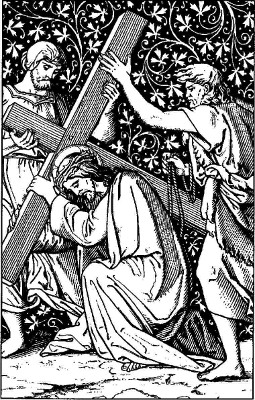
Jesus Falls the First Time


The Lord laid upon him the guilt of us all. - Isaiah 53:6
This is the first of three times during the Stations of the Cross that Jesus falls to the ground. It reminds us that Jesus suffered much on the way to His death. The falls He endured hurt Him very much, because He was so weak and tired from carrying the cross. This station reminds us that we are called to suffer with Jesus and to be willing to accept whatever suffering comes our way.
4th Station
Jesus Meets His Mother
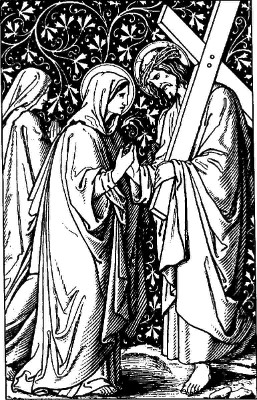

Jesus Meets His Mother


Come, all you who pass by the way, look and see whether there is any suffering like my suffering – Lamentations 1:13
This is one of the most sorrowful stations, because Jesus comes face to face with his mother and she sees how much He has already suffered and will continue to suffer. It reminds us that Mary was with Jesus during His suffering and death and that she suffered along with Him, as she watched her son be tortured by the merciless crowds. She is the perfect example of how we should follow Jesus on His journey to His death.
5th Station
Simon of Cyrene Helps Jesus to Carry His Cross
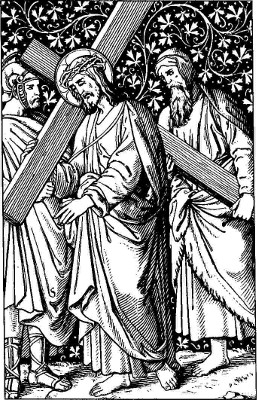

Simon of Cyrene Helps Jesus to Carry His Cross


As long as you did it for one of these, the least of my brethren, you did it for me. - Matthew 25:40
Simon of Cyrene did not want to carry Jesus' cross, and this is very understandable. He would not have wanted to be associated with a criminal and the type of death that was on the horizon for this person. The cross would also have been very heavy, so it would not be a pleasant job. However, he was forced to do so by the authorities. Jesus calls us to carry daily crosses, to accept sufferings which occur in our daily lives. We also might want to avoid carrying these daily crosses. We don't want to be inconvenienced or have any troubles in our lives. There is also no one forcing us to accept these crosses. If we don't want to accept them, God doesn't force us to. However, if we want to go to Heaven and be friends and followers of Jesus, we must accept these crosses.
6th Station
Veronica Wipes the Face of Jesus
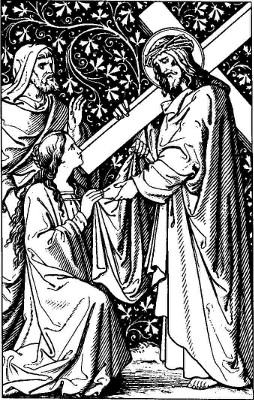

Veronica Wipes the Face of Jesus


He who sees me, sees also the father – John 14:9
Although the account of Veronica wiping the face of Jesus is not in the Bible, it comes down to us as a pious story. Veronica must have faced many difficulties and dangers in her endeavor to bring a moment of relief to Jesus, but she was willing to endure these for this act of charity. She was ministering to a man hated by the crowds and escorted by rough soldiers who would have had no regard for a woman. She risked a beating and maybe even imprisonment if the soldiers were in a bad mood. This did not deter her. We cannot offer Jesus a soothing cloth, but we can offer works of charity to our brothers and sisters most in need. We should not be deterred by what the world sees as fitting or unfitting, but rather be ready to assist those who are in most need of our help, even if that comes at a high personal cost.
7th Station
Jesus Falls the Second Time


Jesus Falls the Second Time


Come to me, all you who labor, and are burdened, and I will give you rest. - Matthew 11:28
This is the second of three meditations on the falling of Jesus on the road to Calvary. Every time He fell on that long and difficult journey, He got up again and continued. Unfortunately we sometimes sin. Of course Jesus never sinned, but the failing of His earthly body can be analogous to the failings of our spiritual life. Every time we fail, we need to pick ourselves up, ask for forgiveness, and continue to try to follow Jesus perfectly.
8th Station
Jesus Meets the Women of Jerusalem


Jesus Meets the Women of Jerusalem


Daughters of Jerusalem, do not weep for me, but weep for yourselves and for your children. - Luke 23:2
This story is recorded in scripture, and it is striking that it is recorded because it is the only time Jesus stops to converse with passersby. They are weeping because of the suffering He is undergoing, and they are presumably convinced that He is innocent. Jesus tells them to stop weeping for Him and to weep for themselves and their children. Jesus reminds them that the reason for this way of the cross is the sins of the world. Seeing the suffering of Jesus should invoke sorrow, but not simply because Jesus is suffering. Rather, it should invoke sorrow because it was our sins that caused Him to have to suffer so greatly. We should be concerned with ourselves and our sins and be truly sorry for them. That is the best way to offer relief to Jesus and express our sorrow at His crucifixion.
9th Station
Jesus Falls a Third Time
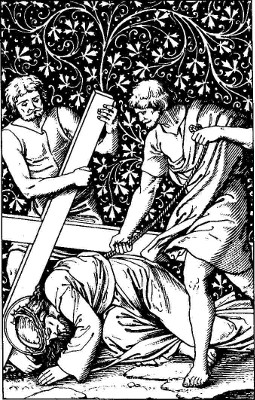

Jesus Falls a Third Time


Everyone who exalts himself shall be humbled, and he who humbles himself shall be exalted. - Luke 14:11
This is the third time in the fourteen stations that we meditate on Jesus falling to the ground under the cross. As His journey continued, it became more and more difficult for Him to continue on, and yet he persevered. This is a wonderful example for us. There can be times in our lives when suffering can seem to be overwhelming or that God is asking too much of us. Looking at this image of Jesus should inspire us. He also had limits to His strength, but every time that strength gave out, He got up again and continued on the way to His death. Every time we experience something which we don't want to continue dealing with but that is necessary, we should also persevere and know that eventually we will be better off for it.
10th Station
Jesus is Stripped of His Clothing


Jesus is Stripped of His Clothing


Every one of you who does not renounce all that he possesses cannot be my disciple. - Luke 14:33
Jesus is stripped of His clothes and the last vestiges of His dignity. After the fall of man in the Garden of Eden, nakedness became a source of shame and a bodily covering was necessary for modesty and for participation in the community. When the clothes are taken off of Jesus, He is finally ready to be put on the cross both to die and be exposed as a public shaming. He will be on the cross with almost nothing covering His body and in a place where people can come and stare at Him. This station recalls that He was humiliated completely. We must also be ready to accept whatever humiliation comes our way on the path of following Jesus.
11th Station
Jesus is Nailed to The Cross


Jesus is Nailed to The Cross


I have come down from heaven, not to do my own will, but the will of him who sent me. - John 6:38
While hanging on the cross for three hours certainly was very painful and ultimately led to His death, this commemoration of the nails being hammered into His hands and feet might have been the most painful part of Jesus' passion and death. To undergo this excruciating pain for the sake of the salvation of all men and women underscores the immense and unfathomable love of Jesus for humanity. No one except Him would voluntarily undergo these tortures and ultimately death. It is a strong reminder that we need to avoid sin and be willing to also sacrifice ourselves to death for love of God and neighbor.
12th Station
Jesus Dies On The Cross


Jesus Dies On The Cross


He humbled himself, becoming obedient to death, even to death on a cross. Therefore God has exalted him. - Philippians 2: 8 – 9
This is the culminating point of the entire stations. All the previous ones have led up to this station. It is through this one act of sacrificial death that Jesus won redemption for all people of all times. As He Himself said, there is no greater love than to lay down one's life for one's friends, and Jesus demonstrates that love for us in Himself. If we are to be true followers of Jesus, we must also be willing to sacrifice our own life for God. In some cases that might mean actually being martyred as a witness for Christ. In many cases, however, it means giving up our own will for the will of God and being ready, if called upon, to do whatever is needed, even to death.
13th Station
Jesus Is Taken Down From The Cross
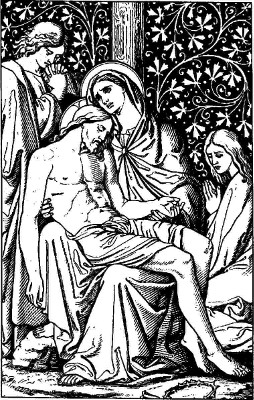

Jesus Is Taken Down From The Cross


Did not the Christ have to suffer those things before entering into his glory? - Luke 24:26
This is a very sorrowful station because there is a desolation present. The overarching image is that of Mary receiving her lifeless son off the cross, and that really underscores that Jesus gave of Himself completely for our sake. It also seems like there is no hope left, for the body of the savior is lifeless and is completely in the hands of others. Luckily there are people there who respect it. Mary's sorrow should be our sorrow, that the sins of the world, and particularly our individual sins, have reduced Jesus to this lifeless body.
14th Station
Jesus Is Placed In the Tomb


Jesus Is Placed In the Tomb


Unless the grain of wheat falls into the ground and dies, it remains alone. But if it dies, it brings forth much fruit. - John 12: 24 – 25
This station brings both hopelessness and hopefulness. The redeemer is lifeless and laid in the tomb. Whatever hope of a savior seems to be gone, as the person of the savior has died and His body is relegated to a tomb. If we don't have the resurrection a few days later, it is indeed one of the saddest and hopeless times ever. Anticipation of the resurrection, though, brings us hope that the burial is not the end of it, but rather a period of waiting and mourning which will soon be replaced with an even greater joy on Easter morning. For us who now know that the resurrection closely follows this burial, this station is a time of mourning but also hopeful anticipation.
